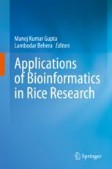Search
Search Results
-
Genetics and evolutionary insights from Solanaceae genome sequences
The availability of genome sequence resources and genomic information enables the functional characterization of genes in crop plants. These genes...

-
Comparative triple-color FISH map** and genome size advances understanding of the cytogenetic diversity in wild Solanum species
Solanum is the most representative and largest genus of the family Solanaceae with numerous important crop species including potato, tomato and...

-
Recent advancement of NGS technologies to detect active transposable elements in plants
BackgroundUnlike peoples’ belief that transposable elements (TEs) are “junk DNAs” or “genomic parasites”, TEs are essential genomic elements that...

-
Pattern matching for high precision detection of LINE-1s in human genomes
BackgroundLong interspersed element 1 (LINE-1 or L1) retrotransposons are mobile elements that constitute 17–20% of the human genome. Strong...

-
Genomic structural variation is associated with hypoxia adaptation in high-altitude zokors
Zokors, an Asiatic group of subterranean rodents, originated in lowlands and colonized high-elevational zones following the uplift of the...

-
The extrachromosomal circular DNAs of the rice blast pathogen Magnaporthe oryzae contain a wide variety of LTR retrotransposons, genes, and effectors
BackgroundOne of the ways genomes respond to stress is by producing extrachromosomal circular DNAs (eccDNAs). EccDNAs can contain genes and...

-
Bioinformatics Analysis Guides to LTR Retrotransposon-Derived Extrachromosomal Linear DNAs Identified by ALE-seq
ALE-seq is a method devised to identify pre-integration intermediates of LTR retrotransposons called extrachromosomal linear DNA, which can be used...
-
Mammalian genome innovation through transposon domestication
Since the discovery of transposons, their sheer abundance in host genomes has puzzled many. While historically viewed as largely harmless ‘parasitic’...

-
Grapevine scion gene expression is driven by rootstock and environment interaction
BackgroundGrafting is a horticultural practice used widely across woody perennial crop species to fuse together the root and shoot system of two...

-
Navigation and Use of Custom Tracks within the Axolotl Genome Browser
The availability of the chromosome-scale axolotl genome sequences has made it possible to explore genome evolution, perform cross-species...
-
Lack of CpG islands in human unitary pseudogenes and its implication
CpG islands (CGIs) are aggregation of CpG dinucleotides in the promoters of mammalian genes. These CGIs are present in almost all the housekee**...

-
De Novo Evolution of Genes in Rice
De novo evolution of genes was used as an important approach in the rice breeding program. The identification of the novel genes in the rice genome...
-
Roles of transposable elements in the regulation of mammalian transcription
Transposable elements (TEs) comprise about half of the mammalian genome. TEs often contain sequences capable of recruiting the host transcription...

-
DeepGRP: engineering a software tool for predicting genomic repetitive elements using Recurrent Neural Networks with attention
BackgroundRepetitive elements contribute a large part of eukaryotic genomes. For example, about 40 to 50% of human, mouse and rat genomes are...

-
The evolution of opsin genes in five species of mirid bugs: duplication of long-wavelength opsins and loss of blue-sensitive opsins
BackgroundColor vision and phototactic behavior based on opsins are important for the fitness of insects because of their roles in foraging and mate...

-
Comprehensive analysis of genomic complexity in the 5’ end coding region of the DMD gene in patients of exons 1–2 duplications based on long-read sequencing
BackgroundDystrophinopathies are the most common X-linked inherited muscle diseases, and the disease-causing gene is DMD . Exonic duplications are a...

-
Identification of high-copy number long terminal repeat retrotransposons and their expansion in Phalaenopsis orchids
BackgroundTransposable elements (TEs) are fragments of DNA that can insert into new chromosomal locations. They represent a great proportion of...

-
LncRNA Biomarkers of Inflammation and Cancer
Long noncoding RNAs (lncRNAs) are promising candidates as biomarkers of inflammation and cancer. LncRNAs have several properties that make them...
-
SARS-CoV-2 helicase might interfere with cellular nonsense-mediated RNA decay: insights from a bioinformatics study
BackgroundViruses employ diverse strategies to interfere with host defense mechanisms, including the production of proteins that mimic or resemble...

-
GENCODE Annotation for the Human and Mouse Genome: A User Perspective
The GENCODE project provides comprehensive annotation of the functional elements in human and mouse genomes with high accuracy. The annotations are...
